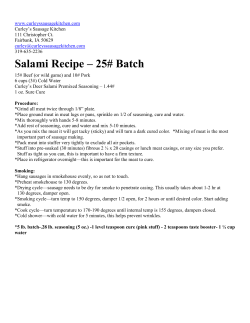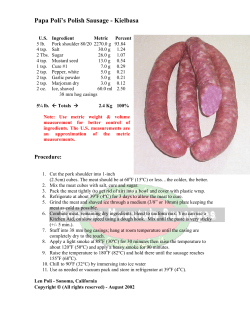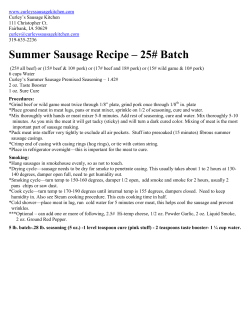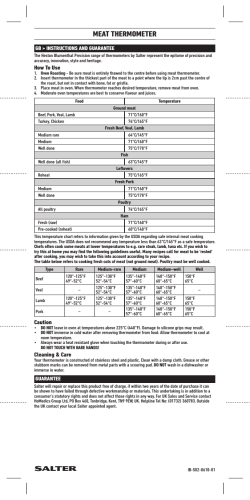
Secrets to Better Braising H OW TO MAKE DELICIOUS POT ROAST
Secrets to Better Braising HOW TO MAKE DELICIOUS POT ROAST BY P AUL NEHRING NEW GRASS FARM, WAUSAU , WI 715-675-0688 When I discuss grilling, roasting, and frying, most people know what I am talking about. However, if I mention braising I usually get a blank look, since the term just isn’t part of our normal cooking vocabulary any more. So, I mention “pot roast,” and then their eyes light up with recognition. Pot roast, which is braised roast, is something that just about everybody remembers Mom making for Sunday afternoon dinner. Today braising seems like a lost art, because we want everything to be fast and ready in 30 minutes or less. It’s unfortunate, because braised roast, stew, or short ribs are easy to cook, and make a delicious one pot meal, with even better leftovers. While braising takes time, usually several hours; the time that it’s cooking is mostly unattended time, allowing us to do other things. A house that is filled with the mouthwatering aroma of the cooking roast is one of the wonderful side benefits. So what is braising? I like how chef Molly Stevens describes it in her terrific book, All About Braising. “At its most basic, braising refers to tucking a few ingredients into a heavy pot with a bit of liquid, covering the pot tightly, and letting everything simmer peacefully until tender and intensely flavored…The miracle of braising lies in the fact that the process demands so little from the cook yet what actually occurs is quite complex and wonderful.” One of the great things about braising is that you can take inexpensive, flavorful cuts of meat such as chuck roast, brisket, or short ribs and turn them into tender, melt in your mouth, one-pot meals. Also, while it is easy to overcook an expensive steak with just a minute or two of inattention over a hot grill, post roast is much more forgiving. Braising relies on long cooking times at low temperatures. If you happen to get distracted for a half hour, it’s not going to ruin your roast. When you cook steak or tenderloin you typically don’t want the internal temperature of the meat to go above 145 degrees, or the finished product will be WWW . NEWGRASSFARM . COM tough and dry. With braising, though, the internal temperature of the meat should reach 210 degrees for over an hour. By doing so, the meat will become tender and moist. How does this work, and why don’t the high temperatures make the meat tough during braising? There are two reasons for this, moisture and collagen: When you grill or roast you rely on dry heat to cook the meat, but when you braise you rely on moisture to cook the meat, which also keeps it from drying out. Collagen is a little more complex. Collagen is the chewy connective tissue gives muscles elasticity. Tender cuts of meat such as tenderloin and ribeye have very little collagen, in part because these muscle groups do very little work for the animal, so they don’t need to have the extra connective tissue for strength. The chuck, however, which comes from the shoulder, obviously, gets plenty of exercise and needs collagen to keep the muscles working together. One plus of all that exercise, is that it actually increases the amount of flavor in the meat. Chuck has a much richer and more complex, “beefy” flavor than tenderloin, but we need to deal with the collagen to make it more palatable. It just so happens that the long, simmer that happens in braising helps to transform the collagen. When the meat temperature reaches 210 degrees the collagen begins to “melt” and turn into gelatin. It takes about an hour at this temperature in a typical roast for the collagen to complete the transformation. That’s why good recipes will suggest a 3-4 hour cooking time, because it takes time for the roast to slowly get up to the proper temperature, and time to hold it there. When the collagen turns into gelatin, it makes the roast taste moist and succulent. It also gives your sauce a wonderful silky texture. There are many good recipes for braising meat. Most of them will work well for you if you follow the following braising basics: 1. Salt the meat a day ahead of time. This is optional, yet, it helps improve the flavor and tenderness of the meat. The salt will dissolve and will be pulled into the meat, so the flavor is throughout the meat, and not just on the surface. The salt also helps activate enzymes that tenderize meat. Again, this is optional, and if you don’t have time to do this step, you can salt the meat right before browning. 2. Choose a thick bottomed pot to cook the roast. Dutch ovens work well for this, especially enamel glazed versions. However, heavy bottomed stainless steel works well too. a. Make sure it isn’t too big or too small for the roast. If it’s too big the steam won’t work properly to cook and keep the roast moist. If it’s too small it will be harder to handle the roast in a cramped space. b. You can use a crock pot or a Nesco, instead of cooking in the oven. Again, make sure they aren’t too big or two small. 3. Brown the meat which adds tremendous flavor to the dish. a. Dry the meat surface with a paper towel, as moisture on the surface of the meat prevents browning. b. Salt, if you have not done so already, and pepper the surface of the meat. c. Use just a small amount of oil, a tablespoon or two is all that is needed. d. Use plenty of space in your Dutch oven or use a fry pan if you need more space. e. Brown under a broiler in your oven, if the fry pan is too small or the meat has some intricate angles that are tough to brown in a pan. f. Be patient, as browning takes 3-5 minutes per side. g. Use medium high heat, not too hot, though, or the meat will burn. h. Don’t walk away at this time. Again, you don’t want the meat to burn. i. Aim for a nice deep brown on all sides of the meat. 4. Don’t be afraid of using a little fat to brown the meat and vegetables. Fat helps to carry flavors and pull them together. 5. Deglaze your pan, or pot, after browning the meat and vegetables. You can use a good wine, stock or water to do this. Just add the liquid to the pan and scrape the brown bits off the bottom. Add this liquid with the brown bits to your sauce. It will be a real flavor booster. If there are burned bits of fond on the bottom of the pan, use a wet paper towel to wipe them out of the pan, being careful to leave the browned bits, which add flavor. a. If you deglaze with wine or other alcohol let it cook for about 8-10 minutes. This will let the alcohol burn off and condense the remaining flavors. b. Cabernet Sauvignon of Shiraz works well, if you are using red wine. Use a good quality wine; it does make a difference. Avoid cheap cooking wines. 6. Remember to use the flavoring herbs and vegetables, or aromatics, in whatever recipe you use. These will combine during cooking to create delicious complex flavors. 7. Your braising liquid should come up to about 1/3 the level of the roast. If you need to leave the roast to cook for more than several hours, add more liquid. Too much liquid, though, will make the sauce too thin and bland. 8. You want the stock to come to a simmer and stay there during the remaining cooking time. So, check it, and turn the temperature up or down to ensure this happens. 9. Turn the roast with tongs every 45 minutes or so, to keep the surface of the meat from drying out. 10. Before serving, degrease the sauce by using a wide, flat spoon to scoop out the grease. You don’t have to get every last bit. Leaving some of the fat will add a little richness and flavor to the sauce. I usually like to serve the roast in thick slices with rice, noodles, or potatoes, topped with a generous portion of gravy. Enjoy! Good books about braising: All About Braising by Molly Stevens Steaks, Chops, Ribs and Roast by Cooks Illustrated If you are looking for delicious grass-fed meat with no hormones, antibiotics or pesticides, give us a call or email: NewGrass Farm, LLC 715-675-0688 [email protected]
© Copyright 2026









